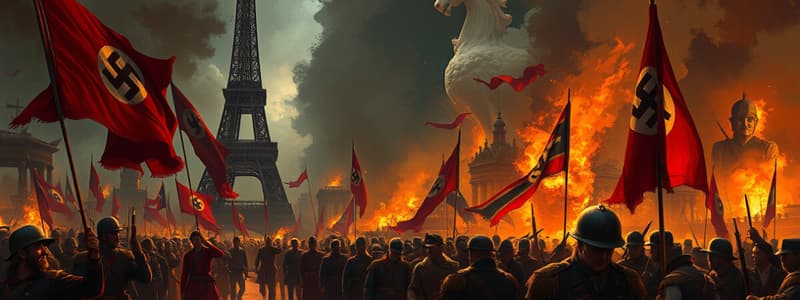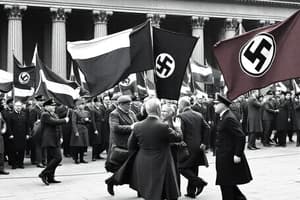Podcast
Questions and Answers
What key change did the Declaration of the Rights of Man and Citizen bring regarding speech and expression in France?
What key change did the Declaration of the Rights of Man and Citizen bring regarding speech and expression in France?
It proclaimed freedom of speech and expression as a natural right.
How did the dissemination of printed material change during the aftermath of the Old Regime?
How did the dissemination of printed material change during the aftermath of the Old Regime?
Printed material such as newspapers, pamphlets, and books flooded towns and reached the countryside.
What role did plays and songs play in the cultural shift in France during this period?
What role did plays and songs play in the cultural shift in France during this period?
They attracted large audiences and helped people identify with concepts like liberty and justice.
What was the effect of freedom of the press on opposing views and political discourse?
What was the effect of freedom of the press on opposing views and political discourse?
In what way did the ability to express ideas in print benefit the general public?
In what way did the ability to express ideas in print benefit the general public?
How did printed pictures contribute to the communication of political ideas during this time?
How did printed pictures contribute to the communication of political ideas during this time?
What limitations existed prior to the Declaration regarding who could understand political texts?
What limitations existed prior to the Declaration regarding who could understand political texts?
What was one major cultural activity that helped unify public sentiment during the political changes?
What was one major cultural activity that helped unify public sentiment during the political changes?
What effect did the takeover of church assets by the state have on public perception during this period?
What effect did the takeover of church assets by the state have on public perception during this period?
How did censors of the Old Regime restrict cultural activities?
How did censors of the Old Regime restrict cultural activities?
Flashcards are hidden until you start studying
Study Notes
Rise of Nazism
- Nazism is characterized by an intricate system operating at various levels, leading to violence and tyranny.
- Indian perspectives varied; some admired Hitler while most disapproved, viewing Nazism with horror.
- The modern world’s history intertwines stories of freedom and democracy with violence and oppression.
The French Revolution
- Paris on July 14, 1789, was alarmed by the king's troops, sparking rumors of potential violence against citizens.
- A militia formed, attracting about 7,000 individuals who sought arms by attacking government buildings.
- The storming of the Bastille symbolized the struggle against monarchical oppression; its destruction was a significant revolutionary act.
- Only seven prisoners were found during the Bastille's storming, yet its demolition became a powerful symbol of resistance.
Estates General and Political Tensions
- The Third Estate, representing the prosperous yet marginalized sectors, faced exclusion in political assemblies.
- Members of the Third Estate demanded a reform in voting procedures, advocating for one member, one vote.
- King Louis XVI rejected their proposal, prompting a walkout by the Third Estate in protest.
National Anthem and Societal Changes
- "La Marseillaise," the national anthem of France, was sung by volunteers from Marseilles, reflecting revolutionary fervor.
- Revolutionary wars brought hardships, leaving women to manage families and finances during the conflicts.
- Dissatisfaction with the 1791 Constitution arose, as political rights were restricted to wealthier citizens.
Political Clubs and Jacobin Movement
- Political clubs became platforms for discussing policies and taking collective action; the Jacobins became the most prominent.
- Jacobins represented less affluent societal groups, including artisans and daily wage workers, under leader Maximilien Robespierre.
- The Jacobin club fostered a culture of citizenship, replacing traditional address forms with Citoyen (Citizen) for all.
Radical Reforms and Repression
- Under Robespierre’s leadership, radical policies included closing churches and repurposing their buildings.
- Robespierre’s unyielding methods triggered calls for moderation even from his supporters.
- He was ultimately arrested and executed via guillotine in July 1794.
Freedom of Expression and Media
- The revolution dismantled previous censorship, establishing freedom of speech as a natural right.
- A surge of publications, including newspapers and pamphlets, spread revolutionary ideas across France.
- Diverse viewpoints thrived in this newfound freedom, with various media engaging the public in political discourse.
Cultural Engagement with Revolutionary Ideas
- Artistic expressions like plays and songs mobilized citizen engagement with concepts such as liberty and equality.
- The widespread dissemination of ideas through print enabled the population to grasp complex political theories previously limited to the educated elite.
Studying That Suits You
Use AI to generate personalized quizzes and flashcards to suit your learning preferences.




